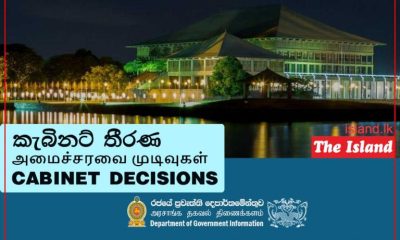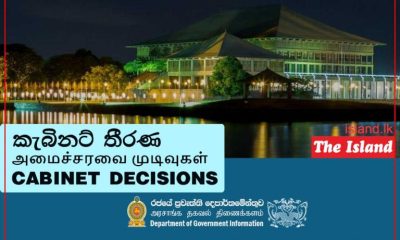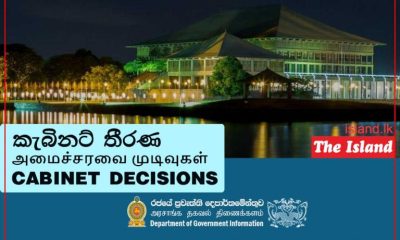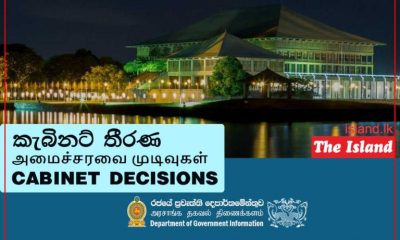Features
The Knuckles Range
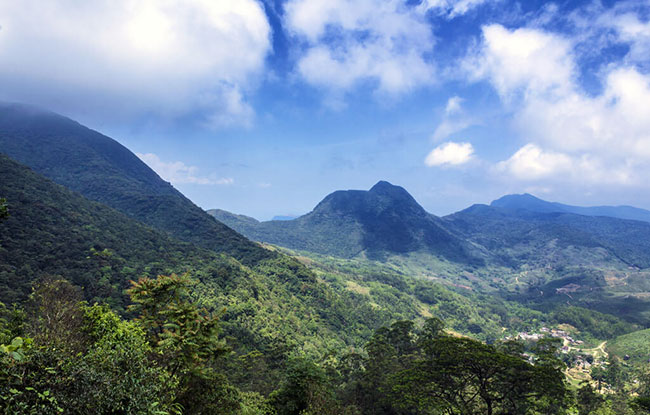
by Dishana H. Uragoda
My first jungle trips were made with the family. The very first, as far as my memory goes, was in the mid 1970s, when we travelled in an Austin A 60 car to Lahugala, Ampara, Batticaloa, Polonnaruva and Sigiriya. I was probably five years old at the time. Since then there were a number of such long trips we made as a family, until 1984 when we joined Mr. Meryl Fernando and his traveling companions on a trip to Rakwana.
It was on this trip that I made my first memorable jungle hike, which was to the famous Waulpane cave. Since that trip, we made a number of trips to Yala where we based ourselves at the Palatupana bungalow run by the Wildlife and Nature Protection Society. We used to make those trips in Uncle Meryl’s Mitsubishi J40 jeep and trailer, driven by the dear driver Simon, whose nephew Wimaladasa was in charge of the bungalow at Palatupana.
During this period, another anchorman to our trips stepped into our lives. He was Senath Abeygunawardena, who was a close friend of my brother. In subsequent years, we made many trips with a group of friends whom he introduced to our family, such as Bimal Perera, Niranjan Perera and Imaran Seneviratne. In fact, we still continue to go on trips with them, together with my sister’s father-in-law, Dr. Walter Gooneratne, Air Vice Marshall Paddy Mendis and the Vernon Edirisinghe family. In between, there was another group with whom I made a number of trips during the early 1990s, and it is one of these that I wish to elaborate on.
It all began when I joined an institute in Colombo to read for a degree in computer science in August 1990 shortly after leaving school. Here I came across a bunch of boys who developed a keen interest in sharing the thrills of traveling in Sri Lanka. Their interest may have been partly created by their seeing my photographs and listening to my narrations of interesting incidents of trips undertaken with my family. The interest so created resulted in altogether five trips being made during end-of-semester holidays to interesting places, namely Adam’s Peak, Horton Plains, Namunukula, Anuradhapura and the Knuckles. These trips were filled with laughter, gossip, bullying and idle talk. They were all budget trips leading a frugal existence, and that made them all the more interesting. After our three years at the institute, almost all of us joined universities in the USA and are now dispersed round the world, yet most of our links and friendships remain as before.
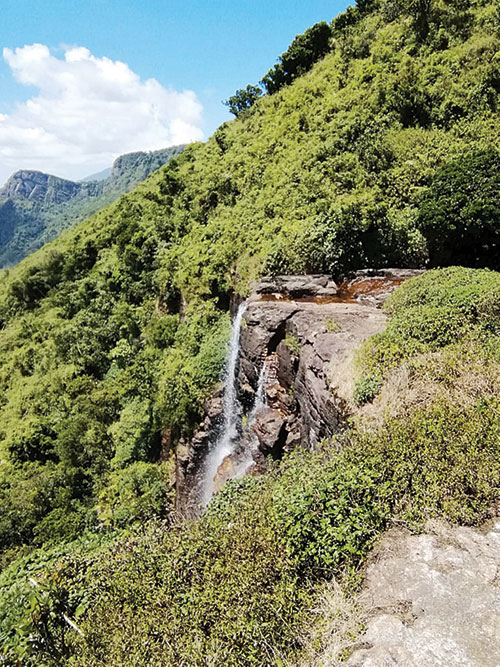
Planning the trip
At the institute we had two weeks holidays in between semesters, and had to squeeze in all the action and relaxation we could think of within that period. On this particular occasion, we decided on the Knuckles region as our destination. I had some experience of the area, having been there twice before on family trips, one of which was a successful attempt at reaching the famous Nitre Cave. The other trip was a total disaster, with heavy rains, strong winds, earthslips, floods and leeches. We planned the present trip in order to avoid the rainy season.
On one of these earlier visits, I happened to obtain the address of the Village Headman of Kumbukgolle off Meemure. He was Heenbanda alias Polgas Seeman Aiya, who was a respectable-looking, small built, lively man in his 50s. My brother and his friends had spent a few nights with him some years earlier on one of their trips; hence I knew we had a chance of spending a few nights with him. After a letter or two of correspondence, we were assured of a place to spend the nights. Our targets were the Nitro Cave and Lakegala Peak of the Knuckles range.
The former could be reached by using Heenbanda’s home as the base, but to get to Lakegala, we had to find accommodation in the more famous village of Meemure. Since we did not have any contacts there, we were considering either the school or the temple as our base. As a backup plan, we were contemplating the possibility of camping out. We had no idea where to camp, but we knew the river Heen Ganga wound through Mimure and it would be practical to camp on its bank.
Six persons agreed to make the trip, and they were Azard Barie, Chandima Wimalasena, Nishantha Nawalage, Tharaka de Silva, Udara Gunawardena and myself. We tried very hard to convince a regular member of our team, Lakshita Surasinghe as well, but he opted out with a trivial excuse. Looking at this list of names today, they have all turned out to be Information Technology professionals of different flavours based around the globe. One sad fact is that our dear friend Azard Barie is no more. He passed away in the UK in January 2003. As would be expected, we were all bachelors then, but now are either fathers, fathers-to-be, separated, fiances, singletons or playboys.
We planned to be out for three nights and hence the food had to be anything that lasted without refrigeration for a few days. We knew we would be provided with food at Heenbanda’s, but we had to stock ourselves with some for the balance period, the easiest being instant noodles, sliced bread, tinned fish, butter, jam and some biscuit packets. We expected to obtain water of pristine purity from the streams found in the Knuckles. While this settled the food problem for me, there were protests from the rest of the boys, who were all heavy eaters and seekers of comfort. They had a notion that I knew somewhat better than they regarding trips and went on with my recommendations, but now I feel they made a mistake!
Backup plan of camping was a favourable option to putting up at a school or temple, and we decided to prepare ourselves for it. We required two tents, a portable kerosene cooker, and at least one kerosene lantern. I had two tents which we regularly used on our family trips. We bought a kerosene cooker, and a few of us obtained lanterns from home.
The next step was to figure out the route to be taken. I obtained some help from my father who knew these areas better than we did. We decided to go to Kandy, and then to Hunasgiriya, where we were to turn towards Looloowatta Estate and reach the beautiful Corbet’s Gap, where the road branched off west to Mimure (3 km) and east to Kumbukgolla (3 km). The next major hurdle was organising transport. In all our previous college trips we used public transport, but this trip required a vehicle. For our good fortune, Chandi’s father allowed us the use of his Toyota Lightace van, and all was set to go.
Trip at last
Departure was set for Wednesday, August 12, 1992, and return was three nights later, on Sunday 15th. The dates were selected to take advantage of the full moon of Nikini poya, which fell on the 13th. All food items, provisions, tents, a large haversack, kettle, kerosene cooker, lamps and other paraphernalia were packed in Chandi’s van the previous night. Early next morning, along with our personal items, we left Colombo. It was a great start despite the short delay and the rather harsh rock music that blared into my ears at the back of the vehicle. The two experts who provided the music were Chandi and Nish. Their preferences were a far cry from the peaceful pop or country music that I appreciated, but for my luck Nish had brought a few cassettes of my flavour.
Many of us had brought sandwiches for breakfast, which we had whilst on the move. The idea was to lose as little time as possible by way of wayside stops. As expected, the van was in an explosive atmosphere with much chattering and laughter. After a while, we began trying out our singing skills. Tharaka knew much of the “Big match” style of Sinhala songs, while Azard and I were somewhat proficient in regular baila songs. Nish was an expert of English pop songs to which we would listen with admiration.
The drive was rather slow and comfortable with Chandi at the wheel. We reached Kandy around 10 am, and we decided to wander around the town and eventually break journey by going to the house of Nish’s aunt for snacks and drinks. After delaying a short time in Kandy, we again took the road. Though the road conditions were not at their best, it was quite a scenic route. We passed the Victoria reservoir, where the water level was low at the time, and reached Hunnasgiriya around 2.30 pm. There, with the help of directions from a wayside villager, we proceeded north towards Looloowatta Estate.
Road conditions became less comfortable and we had to proceed quite slowly, with the van bouncing along. For our luck, there was no rain although it was pretty overcast. By 3.45 pm or so we reached Looloowatta Estate, and though all were now hungry, there was no time to waste as our overall plan of reaching Kumbukgolla in time was of higher priority. With the cloudy sky, it turned out to be slightly chilly.
At the small town of Looloowatta, we stopped for directions once again, and there we were asked if we could give three hefty men a lift to Mimure. We did not think it was a good idea to overload the vehicle. Then two of them explained to us that the third member was the officer in charge of the Police Station at Mimure, and requested us to oblige by giving only him a lift. We agreed and put him in the front seat. Chandi wanted me to take the wheel. One reason was his being tired, and the other was his thinking that I was better at keeping the guest company.
Knuckles
This was the first time I was driving a van, and I took off in the manner of driving the Land Rover back home. However, it did not take long to figure out that the van had much softer suspension as it bounced and oscillated frightfully. I proceeded slowly on the road going northwards towards Corbet’s Gap and admiring the beautiful mountain scenery amidst the coolness of the evening. The vegetation around and the long grass that covered the sides of the road were added attractions. I kept on chatting with the policeman, who gave relevant details of the area and pointed out the various mountain peaks, but the others at the back of the van observed silence, probably induced by hunger. We had proceeded a few kilometres down the road and I was keeping slightly to the left, as there was a deep drop into the ravine below on the right. There was plenty of grass on the roadside to the left. I enjoyed the beautiful view while driving.
Suddenly there was a loud explosion which shook the whole vehicle. I felt it strongly on the steering. There was an eerie rumble as I slowed down the vehicle to a stop. We were in a state of shock and surprise. We got down in a hurry and rushed to check what was wrong. We found the left front tyre deflated with a two-inch gash on it. It was a huge blow to us since we had a long way to go and we could not proceed without a spare wheel. I was upset as it was I who was driving Chandi’s van. We were wondering what caused the gash in the tyre as there was apparently nothing on the surface of the road to account for it. However, on closer inspection, we discovered rocks with jagged edges under the soft carpet of beautiful grass on the roadside. One of them was likely to be responsible for the damage.
It was a rude introduction to the new terrain we were in. The policeman, who was rather calm, had a look at the tyre and declared he would get it repaired so that we could collect it when we visited Mimure a day later. He sounded rather confident, and that gave us some relief. It also made us realise how lucky we were to have given him the lift. He also gave us permission to camp next to the bridge over the river Heen Ganga, a tributary of Mahaweli, that went through Meemure.
I let Chandi take over the wheel since I was feeling rather bad at what had happened. We passed the beautiful Corbet’s Gap and eventually came to the fork on the road. The road up to this point was tarred and very much motorable. But now, both branches of the fork were typical jeep tracks with large rocks on the gravel surface. The time was around 4.30 pm and it was getting late. We took the left branch going to Mimure to drop the policeman. A few of us had to literally walk with the vehicle, moving aside rocks on the road that could damage the tyres and the suspension. Driving was not getting any easier, with the eyes straining to watch out for danger spots.
We proceeded a good two km before we came to the police station, at which point the policeman got down with the damaged wheel in his care. We came back on the same route, and then went down the other branch of the fork, going west to the Kumbukgolla village. The road was no better, and we eventually came to Kumbukgolla around 6 pm.
Heenbanda’s house was only about 100 metres away, yet we had to take the van across a dry tributary of Heen Ganga that was studded with boulders. By this time, word had got round of our arrival and Heenbanda, accompanied by many villagers, was there to greet us. We were accorded a warm welcome and Heenbanda was happy to see me. We talked of our previous trips there, as well as my brother’s. Heenbanda wanted us to take the vehicle to his house and taking command of the operation, he ordered and directed the villagers around who virtually lifted the van across the difficult, large rocks.
The sun had set a good half an hour earlier, yet there was some daylight available. So we rushed into unloading only our bags and a few other essential items, as we knew we had to take off to Mimure the next day. We were getting accommodation in one huge room, which was a good portion of Heenbanda’s house. It had a neatly tiled roof, a cemented unpolished floor, white plastered walls and sufficient furniture for us to sit and make ourselves comfortable.
We were all eagerly waiting to have a wash, when we were informed that it would have to be at the river that we crossed. Since we were all dog-tired, a bathroom would have been most welcome. Now that we had to walk upstream searching for water in the dark and in cold weather, the eagerness to have a bath was somewhat diluted. Heenbanda was sending a guide with us to take us to the bathing spot, and we motivated ourselves to rush with the wash as there was still some light outside. We walked upstream about 100 metres from where we crossed the river, and there it was, water being channeled along strips of banana stems acting as a gutter. The water was quite cold, but after completing the wash with the help of kerosene lamps, it was indeed quite refreshing. We rushed back to our abode shivering and got into warmer clothes.
Heenbanda and his wife, a nice quiet and elderly lady served us with an early dinner and we were once again rejuvenated. There was no electricity but a number of kerosene oil lamps were lit, and we were provided with woven mats, one each for the six of us to sleep on. Once bedding was arranged, we had Heenbanda’s permission to take a walk in the night. We stepped out with our torches, and it was a beautiful night with plenty of moonlight. I proudly took a branded American 3-cell torch, which was very effective and not very common at the time. We decided to walk to the riverbed to relax, and then as the ever-so-hungry or thirsty lot wanted to have coffee, I thought it best to test the new kerosene cooker. We took it out of the van with the kettle, cups, coffee, milk and sugar, and took a cool walk to the riverbed.
(To be continued)
Features
‘Silent Majority’ abandoned to Long-suffering in regional conflicts

 With reports emerging that India has attacked some ‘sites’ in Pakistan and Pakistan-administered Kashmir, the question could be posed whether the stage has just been set for yet another costly India-Pakistan military conflict. Sensible opinion in South Asia could only hope that wise counsel would sooner rather than later come to prevail on both sides of the divide and that they would draw back from the brink of full-scale war.
With reports emerging that India has attacked some ‘sites’ in Pakistan and Pakistan-administered Kashmir, the question could be posed whether the stage has just been set for yet another costly India-Pakistan military conflict. Sensible opinion in South Asia could only hope that wise counsel would sooner rather than later come to prevail on both sides of the divide and that they would draw back from the brink of full-scale war.
The states concerned ought to know fully well the possible wide-ranging weighty consequences of another regional conflict. It should be plain to see that it would benefit none in the two theatres of confrontation, most particularly the relevant publics or the ‘Silent Majority’.
In fact, in connection with the mentioned initial military attacks, the Pakistani side has gone on record that some civilian lives have been lost. Such losses could burgeon in the event of full scale hostilities. These costs could of course be staggering and unimaginable in the event the nuclear option is resorted to by the sides, going forward.
Accordingly, the hope of the peace-loving world-wide is likely to be that India and Pakistan would give negotiations a chance and resolve their differences peacefully. It would be in the best interests of the world for the champions of peace to join their voices to that of UN chief Antonio Guterres and call on the sides to negotiate an end to their differences.
The utter helplessness and misery of the people of the Gaza ought to drive home afresh the horrors of war. Currently the news is that the Gazans are literally starving to death. Food and other essentials provided by UN agencies are reportedly being prevented by Israel from getting to the hapless people of Gaza. So dire is their situation that concerned quarters are calling on the compassionate worldwide to provide the Gazans with food, water and other essentials voluntarily. This SOS would need to be heeded forthwith.
Accordingly, it could be inferred that most formal arrangements, including those that are generally under the purview of the UN, geared to providing emergency humanitarian assistance to the needy, have, for all intents and purposes, been rendered ineffective in the Gaza. The UN cannot be faulted for this state of things; rather, Israel should be held accountable in the main for it.
The matter of accountability is central to the dramatic slide into lawlessness the world has been experiencing over the past few decades. As could be seen, International Law is no longer fully applicable in the conflict and war zones of the world because it is not being adhered to by many state and non-state aggressors. That the UN is hapless in the face of such lawlessness is plain to see.
We have of course the Middle East wherein International Law has fallen silent for quite a while. How could it be otherwise, when Israeli aggressions are being winked at by the US, for which the policy of backing Israel is almost sacrosanct?
Moreover, under President Donald Trump, it is difficult to see the US changing policy course on the Middle East. Trump made vague promises of bringing peace to the region in the run-up to his reelection but has done nothing concrete by way of peace-making. Consequently, complete lawlessness prevails in the Middle East. US policy towards Israel counts as another example of how the self- interest of US central administrations blinds them to their international obligations, in this case Middle East peace.
However, the commentator could be criticized as being biased if he holds only Israel responsible for what has befallen the Middle East. It has been the position of this columnist that Israel’s security needs should be taken cognizance of by its state and non-state adversaries in the Middle East and acted upon if the basis is to be laid for a durable Middle East peace. Inasmuch as Palestinian statehood must be guaranteed, the same should be seen as applicable to Israel. The latter too enjoys the right to live in a secure state of its own, unopposed by its neighbours.
The Ukraine of today is also sad testimony to the ill consequences of powerful, aggressor states wantonly disregarding International Law and its obligations. Nothing could justify Russia in invading Ukraine and subjecting it to a condition of Longsuffering. Clearly, Ukraine’s sovereignty has been violated and such excesses go to the heart of the current state of ‘International Disorder’. Of course the same stricture applies to the US in relation to its military misadventures in Afghanistan and Iraq, to name just two such modern examples.
There is no ducking the fact, then, that civilian publics in the mentioned theatres of war and outside, are being subjected to the worst suffering as a consequence of the big powers’ self-aggrandizement schemes and military misadventures. Longsuffering becomes the tragic lot of the people who have nothing to do with such unbridled power ambitions.
One would not be exaggerating the case if he states that civilian publics count for almost nothing in the present ‘International Disorder’. Increasingly it is becoming evident that from the viewpoint of the big powers and authoritarian governments the people are of little or no importance. Considering that self-aggrandizement is of the paramount interest for the former the public interest is coming to be seen as inconsequential.
Consequently, not much of a case could be made currently for the once almost reverentially spoken of ‘Social Contract’. For, the public interest does not count for much in the scrambles for power among the major powers who are seen at the popular level as the principal history-makers.
It is in view of the above that much is expected of India. Today the latter is a ‘Swing State’ of the first importance. Besides being a major democracy, it is one of the world’s principal economic and military powers. It possesses abundant potential to help to put things right in international politics. If there is one state in Asia that could help in restoring respect for International Law, it is India.
Considering the above, India, one believes, is obliged to bear the responsibility of keeping South Asia free of any more long-running, wasting wars that could aggravate the material hardships and socio-economic blights of the region. Thus, India would need to consider it imperative to negotiating peace with Pakistan.
Features
Memorable happening … Down Under

 Under the Global-Ise Australia Advanced Sports Development Programme, a delegation of 15 swimmers from Lyceum International School, Wattala, had the remarkable opportunity to train and experience high-performance sports development in Melbourne, Australia.
Under the Global-Ise Australia Advanced Sports Development Programme, a delegation of 15 swimmers from Lyceum International School, Wattala, had the remarkable opportunity to train and experience high-performance sports development in Melbourne, Australia.
The 10-day programme was carefully curated to offer intensive training, educational exposure, and cultural experiences for the young athletes.
The swimmers underwent specialised training through Swimming Victoria’s elite programme, held at some of Melbourne’s premier aquatic facilities.

Visit to Victorian Parliament
Each day began as early as 5:00 a.m. and continued until 7:00 p.m., ensuring a rigorous and enriching schedule that mirrored the standards of international competitive swimming.
Beyond training, the programme offered a wide array of experiences to broaden the students’ horizons.
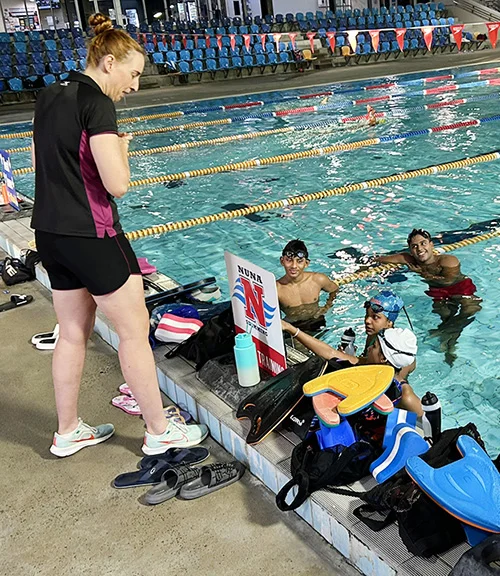
Morning training
The tour group explored iconic landmarks such as the Victorian Parliament and the Melbourne Cricket Ground (MCG), and enjoyed shopping at Chadstone – The Fashion Capital. They also experienced the natural beauty of Victoria with visits to Yarra Valley Chocolaterie & Ice Creamery, and Cardinia Reservoir Park, where they observed kangaroos in their natural habitat.
An academic highlight of the tour was the group’s exclusive visits to three of Australia’s leading universities: the University of Melbourne, Monash University, and Deakin University. These visits aimed to inspire students and showcase the vast educational opportunities available in Australia.
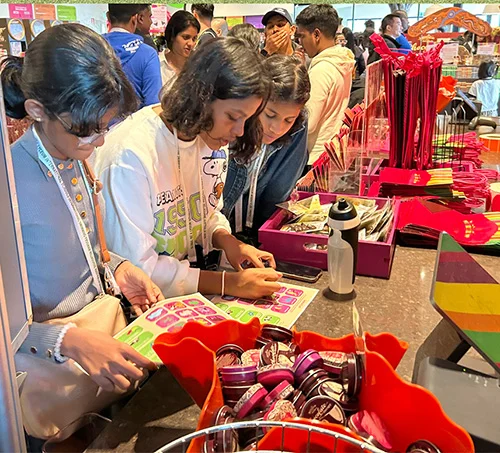
Checking out the scene at Yarra Valley Chocolaterie & Ice Creamery
As part of the cultural immersion, Global-Ise hosted a traditional Australian BBQ at the Tim Neville Arboretum in Ferntree Gully. The students also enjoyed a variety of diverse culinary experiences each evening, further enriching their understanding of local and international food cultures.
The tour concluded with a celebratory dinner at the Spicy Wicket Restaurant, where each participant received a presentation in recognition of their involvement.

Enjoying an Aussie BBQ for lunch
The evening was made especially memorable by the presence of Pradeepa Saram, Consul General of Sri Lanka in Victoria.
Global-Ise Management—Ken Jacobs, Johann Jayasinha, and Dr Luckmika Perera (Consultant from the University of Melbourne)—did a magnificent job in planning and the execution of the advanced sports programme.

Coaches from Sri Lanka presenting a plaque to Global-Ise Management team
Ken Jacobs (centre), Johann Jayasinha, and Dr Luckmika Perera (on the right
Features
Bright, Smooth Skin

 Hi! How’s the beauty scene keeping with you?
Hi! How’s the beauty scene keeping with you?
Phew, this heat is awful but there is nothing that we can do about it.
However, there are ways and means to take care of your skin and I will do my best to help you in every way I can.
Well, this week, let’s go for a Bright, Smooth Skin.
Gram flour (also known as besan) is a traditional skincare ingredient known for its:
* Natural exfoliating properties.
* Ability to absorb excess oil.
* Gentle brightening and tan-removal effects.
* Suitability for all skin types, especially oily and acne-prone skin.
You will need 01–02 tablespoons gram flour (besan) and rose water, or raw milk, to make a paste.
You could add the following two as optional add-ins: A pinch of turmeric (for extra glow), and a few drops of lemon juice (for oily skin and pigmentation)
Add the gram flour to a small bowl and mix in the rose water (for oily/sensitive skin) or raw milk (for dry skin) slowly.
Stir well to make a smooth, spreadable paste—not too thick, not too runny.
Now apply this mixture, evenly, to your damp face and neck, and let it sit for 5–10 minutes (don’t let it dry completely if you have dry skin).
Gently massage in circular motions using wet fingers—this helps exfoliate.
Rinse off with lukewarm water, and then pat your skin dry.
Use it 02–03 times a week for best results.
Skin Benefits:
* Removes dirt, sweat, and oil without stripping natural moisture.
* Gently exfoliates dead skin cells, revealing smoother skin.
* Brightens the complexion and fades mild tanning.
* Helps clear clogged pores and reduce pimples.
* Leaves skin fresh and glowing—perfect for humid climates.
-

 News6 days ago
News6 days agoRanil’s Chief Security Officer transferred to KKS
-

 Opinion4 days ago
Opinion4 days agoRemembering Dr. Samuel Mathew: A Heart that Healed Countless Lives
-

 Business2 days ago
Business2 days agoAitken Spence Travels continues its leadership as the only Travelife-Certified DMC in Sri Lanka
-

 Business2 days ago
Business2 days agoLinearSix and InsureMO® expand partnership
-

 Latest News1 day ago
Latest News1 day agoNPP win Maharagama Urban Council
-

 Business6 days ago
Business6 days agoCCPI in April 2025 signals a further easing of deflationary conditions
-

 Features6 days ago
Features6 days agoExpensive to die; worship fervour eclipses piety
-

 Features4 days ago
Features4 days agoTrump’s economic missiles are boomeranging



